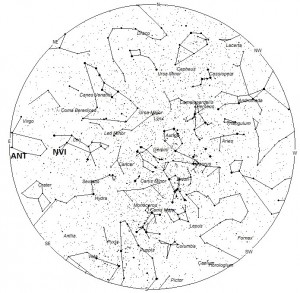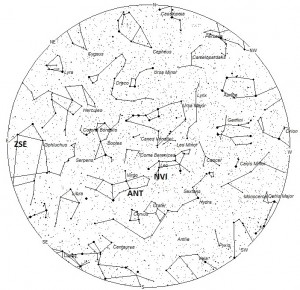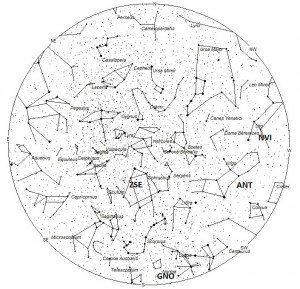
Radiant Positions at 8pm local daylight time

Radiant Positions at 1am local daylight time

Radiant Positions at 6am local daylight time
During this period the moon reaches its first quarter phase on Tuesday March 19th. At this time the moon is located ninety degrees east of the sun and will set near 0100 local daylight time (LDT) as seen from mid-northern latitudes. This weekend the waxing crescent moon will set during the late evening hours, allowing dark skies to prevail during the more active morning hours. The estimated total hourly meteor rates for evening observers this week is near two as seen from the northern hemisphere and four as seen from south of the equator. For morning observers the estimated total hourly rates should be near eight from the mid-northern hemisphere and seventeen from the mid-southern hemisphere. The actual rates will also depend on factors such as personal light and motion perception, local weather conditions, alertness and experience in watching meteor activity. Evening rates are reduced due to interfering moonlightCustomized Inflatables.
The radiant (the area of the sky where meteors appear to shoot from) positions and rates listed below are exact for Saturday night/Sunday morning March 16/17. These positions do not change greatly day to day so the listed coordinates may be used during this entire period. Most star atlases (available at science stores and planetariums) will provide maps with grid lines of the celestial coordinates so that you may find out exactly where these positions are located in the sky. A planisphere or computer planetarium program is also useful in showing the sky at any time of night on any date of the year. Activity from each radiant is best seen when it is positioned highest in the sky, either due north or south along the meridian, depending on your latitude. It must be remembered that meteor activity is rarely seen at the radiant position. Rather they shoot outwards from the radiant so it is best to center your field of view so that the radiant lies at the edge and not the center. Viewing there will allow you to easily trace the path of each meteor back to the radiant (if it is a shower member) or in another direction if it is a sporadic. Meteor activity is not seen from radiants that are located below the horizon. The positions below are listed in a west to east manner in order of right ascension (celestial longitude). The positions listed first are located further west therefore are accessible earlier in the night while those listed further down the list rise later in the night.
The following showers are expected to be active this week:
The Northern March Virginids (NVI) are active from a radiant located at 11:34 (174) +10. This position is located near the Leo-Virgo border between the faint stars Iota Leonis and Nu Virginis. These meteors are best seen near 0100 local daylight time (LDT) when the radiant lies highest above the horizon. Rates would mostly likely be less than one shower member per hour, no matter your location. Since this radiant is located near the celestial equator, this activity can be seen most everywhere. At 22 km/sec. these meteors would have a slow velocity.
The large Anthelion (ANT) radiant is currently centered at 12:36 (189) -05. This position lies in western Virgo, three degrees southwest of the famous third magnitude double star known as Porrima (Gamma Virginis). These meteors may be seen all night long but the radiant is best placed near 0200 LDT when it lies on the meridian and is highest in the sky. Rates at this time should be near two per hour no matter your location. With an entry velocity of 30 km/sec., the average Antihelion meteor would be of slow velocity.
The Gamma Normids (GNO) are active from a radiant located at 16:08 (242) -50. This position lies in central Norma, three degrees west of the fourth magnitude star Gamma Normae. Due to the southerly declination (celestial latitude) these meteors cannot be seen north of the northern tropical regions. They are best seen from mid-southern latitudes where the radiant lies high in the sky near 0500 local summer time. This shower peaked on March 13 so current hourly rates would be near one per hour as seen from south of the equator and less than one per hour as seen from northern latitudes. At 56km/sec. the Gamma Normids would produce mostly swift meteors.
Toward the end of this period activity from the Zeta Serpentids (ZSE) may become detectable. The peak occurs on Thursday March 21st when the radiant is located at 17:34 (264) +02. This position is actually located in eastern Ophiuchus, four degrees southwest of the third magnitude star Celbalrai (Beta Ophiuchi). These meteors are only visible on three mornings centered on the 21st. They are best seen near during the last dark hour before dawn when the radiant lies highest above the horizon in a dark sky. Rates should be less than one shower member per hour no matter your location At 69 km/sec. these meteors would have a swift velocity.
As seen from the mid-northern hemisphere (45N) one would expect to see approximately five sporadic meteors per hour during the last hour before dawn as seen from rural observing sites. Evening rates would be near one per hour. As seen from the mid-southern hemisphere (45S), morning rates would be near fourteen per hour as seen from rural observing sites and three per hour during the evening hours. Locations between these two extremes would see activity between the listed figures. Evening rates are reduced during this period due to moonlight.
The table below presents a condensed version of the expected activity this week. Rates and positions are exact for Saturday night/Sunday morning .
| SHOWER | DATE OF MAXIMUM ACTIVITY | CELESTIAL POSITION | ENTRY VELOCITY | CULMINATION | HOURLY RATE | CLASS |
| RA (RA in Deg.) DEC | Km/Sec | Local Daylight Time | North-South | |||
| Northern March Virginids (NVI) | Mar 14 | 11:34 (174) +10 | 22 | 01:00 | <1 – <1 | IV |
| Anthelions (ANT) | – | 12:36 (189) -05 | 30 | 02:00 | 2 – 2 | II |
| Gamma Normids (GNO) | Mar 13 | 16:08 (242) -50 | 56 | 06:00 | <1 – 1 | II |
| Zeta Serpentids (ZSE) | Mar 21 | 17:34 (264) +02 | 69 | 07:00 | <1 – <1 | IV |
 American Meteor Society
American Meteor Society
I saw what appeared to be a double meteor near my home at lake Lure NC about 9PM on 3/16/2013. One object followed the other with a a large tail. they appeared for about 6 seconds streaking westerly toward Cassiopea as I looked at the North star and big dipper.
My wife and I saw what i thought was a shootong star ,or fire ball around 9 pm march 16th 2013 ;
we were looking at the big dipper facing north north west and we saw a bright light moving fast like a shooting star but long in time set we watch about 5-6 full seconds ,but about 3 sec in it turned bright red, at this time it moved up and down in a wave motion amazing ive never saw one to movr in a slight wave up and downward motion and appeared to be able to hit the ground approx maybe 5 miles up the road from us , but these things can appear to be close when in reality it could be miles .hope this help peolpe learn more anout this sighting , by the way near hwy S.C HWY 11 ,AND S.C HWY 14
I just saw a meteorite over Star Junction, PA. It was just one heading towards west behind Orion constellation. Nice size tall and then it broke up into pieces. March 19, 2013 That was around 10:00–10:30 PM at night.
I just observed a meteorite streaking in the southwest hemisphere. Bright blue in color breaking up. I am in Southwestern CT along the coastline. Marvelous.
[ just saw one, also nice size.very bright white tail. it was about 7:50 p.m. over middle staten island.ny headng south.
3/22/2013
Don’t know too much about all of this. My husband and I saw a green glowing ball with tail fly across the sky for a few seconds and then fall down and just disappear. We saw this at about 8pm in northeast Ohio heading in an easterly direction near the border of PA.
We saw what seemed to be a shooting or falling star this evening in Lancaster county PA. Around 7:50. It seemed so close to ground.
Saw this thing from Staten Island and at first thought it was fireworks. Waited for the bang at the end but it never happened. It had a sparkling trail behind it and a sizzling sound making it seem as if it were fireworks but did not have a fireworks trajectory (arc) it seemed to move more slowly than other meteors I had seen. As I was looking due South, It came from West North West going East South East about 45 degrees above the horizon. I would say it went to the ocean as it traveled at a consistant but what appeared to be a rather low elevation for a meteor and was visible longer than you would expect a meteor to be.
I saw the same in Lancaster county on the 22nd around 7:50 or so. It was a very bright with a long tail. The tail had some green color in it. It was very low and I watched it for about 5 seconds or so. It was traveling north to south and the broke apart. I have seen one larger than this years ago t 4:45 am on my wy to work. I feel very blessed to witness such an awesome display twice.